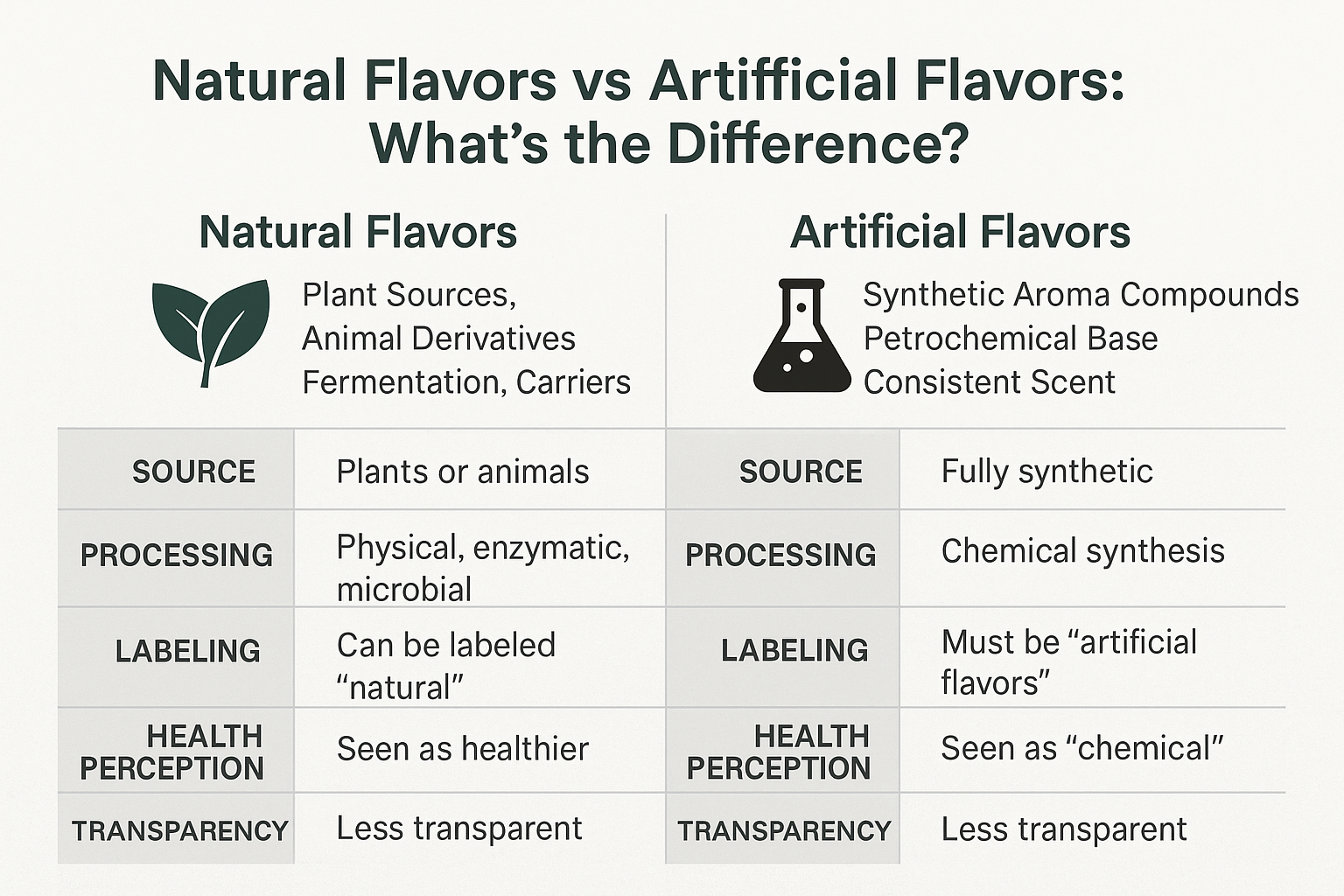🌿 What Are Natural Flavors? | Truth, Definition, and What You Should Know
In today’s era of “clean labels” and conscious consumption, one ingredient label shows up more than most: natural flavors. It sounds harmless—maybe even healthy—but what exactly does it mean?
Let’s break down the definition, how natural flavors are made, what they’re made from, and how they compare to artificial flavors. The truth may surprise you.
🧭 What Does “Natural Flavor” Mean?
At first glance, “natural” might suggest something directly from nature: fresh-squeezed lemon oil, ground vanilla bean, or dried herbs. But in food labeling, it’s not that simple.
🧾 FDA Definition (U.S.)
“Natural flavor means flavoring substances derived from plant or animal sources and obtained via physical, enzymatic, or microbial processes.”
This includes fruit, vegetables, spices, herbs, meat, poultry, seafood, and dairy. The flavor must be extracted without synthetic solvents or harsh chemical modification, but other processing like fermentation, distillation, or roasting is permitted.
🇪🇺 EU Definition (EFSA)
The European Union defines “natural flavoring substances” as materials identified in nature and obtained by natural methods—slightly stricter in some areas, but still allowing a wide range of techniques.
🌿 What Are Natural Flavors Made Of?
Natural flavors can come from plants, animals, or microbial fermentation. They can include:
- Essential oils (e.g. orange, mint, clove)
- Fruit extracts (e.g. lemon oil, raspberry distillate)
- Fermentation-derived compounds (e.g. natural vanillin from rice)
- Animal derivatives (e.g. dairy enzymes, meat-based extracts)
However, they may also include:
- Carriers (alcohol, glycerin, propylene glycol)
- Preservatives (as legally allowed)
- Solubilizers or emulsifiers
⚠️ These “incidental additives” aren’t always listed on the label—making “natural flavors” less transparent than consumers might expect.
⚖️ Natural vs Artificial Flavors: What’s the Difference?
| Attribute | Natural Flavors | Artificial Flavors |
|---|---|---|
| Source | Plants or animals | Fully synthesized in a lab |
| Production Method | Physical, enzymatic, microbial | Chemical synthesis |
| Labeling | “Natural flavors” | Must be labeled as “artificial flavors” |
| Consistency | Can vary batch to batch | Highly consistent |
| Price | Often more expensive | Usually cheaper |
| Consumer Perception | Viewed as healthier | Viewed as “chemical” or synthetic |
🧠 Key Insight:
Natural and artificial flavors can be chemically identical, but differ in their source and how they’re processed. For example, vanillin (vanilla aroma) can be extracted from vanilla beans or synthesized from lignin—yet it smells and functions the same.
⚠️ Are Natural Flavors Actually Healthy?
Not necessarily.
While “natural” implies safety, here’s what you should know:
- Natural ≠ Whole — Most natural flavors are highly refined and isolated compounds.
- They can include allergens — Like dairy or soy, but often not labeled as such unless required.
- They may not be vegan — Animal-derived flavors are common.
- They’re added for taste, not nutrition — No vitamins, minerals, or fiber are involved.
In essence, natural flavors are designed to improve sensory appeal, not health value.
🍹 Where Are Natural Flavors Commonly Found?
You’ll find “natural flavors” on the label of nearly every processed product marketed as:
- Healthy
- Organic
- All-natural
- Plant-based
- Clean-label
Examples include:
- Flavored sparkling water (e.g. LaCroix, Spindrift)
- Protein powders and bars
- Packaged snacks
- Breakfast cereals
- Frozen meals
- Yogurts and smoothies
Even premium food products use “natural flavors” to boost aroma, mask bitterness, or simulate freshness.
🧴 Are Natural Flavors Better Than Artificial Flavors?
Not always. While natural flavors sound more appealing, the differences lie in origin, not function.
- Natural flavors are often less stable, cost more, and may vary in quality.
- Artificial flavors can be more sustainable and precise, though they carry negative consumer perception.
- Both can contain non-flavor chemicals that are not always disclosed (e.g., carriers, solvents).
Bottom line: The term “natural” doesn’t guarantee the product is better, healthier, or safer.
🏷️ How to Read Labels & Choose Smarter
Want to make more informed choices? Here’s how:
- Check for added detail – Some brands voluntarily describe the natural flavor source (e.g., “natural lemon oil”).
- Research the brand – Transparent brands often explain their ingredient sourcing.
- Look for certifications – USDA Organic, Non-GMO, Vegan, or Clean Label Project can provide added insight.
- Beware of vague claims – If “natural flavor” is the only descriptor, you don’t really know what’s in it.
✅ Conclusion: “Natural Flavor” Is a Legal Term, Not a Promise
Despite the warm, earthy vibe the word “natural” conveys, natural flavors are often industrially produced compounds designed for flavor impact, not health.
That doesn’t mean they’re harmful—but it does mean they’re not the same as a squeezed orange or chopped herb.
If transparency matters to you, choose brands that go beyond the label to show what’s really inside—and don’t be afraid to ask, “What’s your natural flavor made from?”

